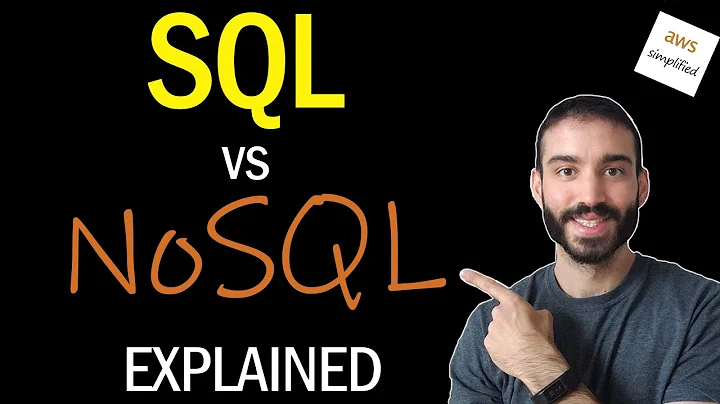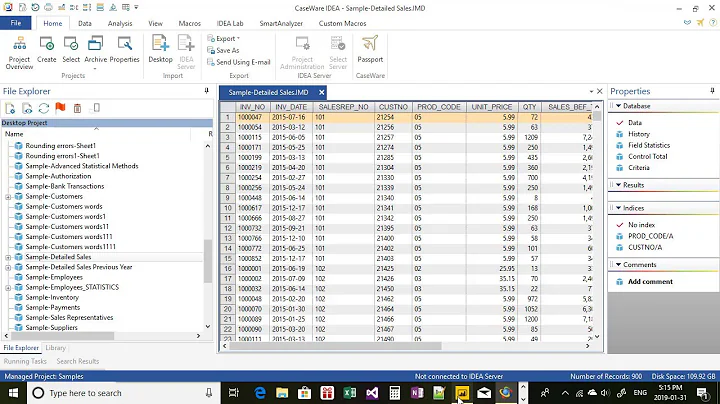Differences Between Drivers for ODBC Drivers
Solution 1
ODBC Driver for SQL Server
ODBC is the primary native data access API for applications written in C,C++, PHP, Python and others for connecting to SQL Server.
It's widely used in data integration scenarios.
Also, it's preferred if you are developing application on Windows and deploying it to Linux .
SQL Server
The full name of SQL Server Driver is SQL Server ODBC Driver. It’s an old driver since sql 2000. You can use it to connect to SQL Server 2016, but you will not be able to access new features and functionality of SQL Server 2016
SQL Server Native Client
SQL Server Native Client is containing both the SQL OLE DB provider and SQL ODBC driver to support native connectivity to SQL Server and support all features of sql server 2016. It's the best in windows environment
SQL Server Native Client RDA
Remote data access (RDA) in Microsoft SQL Server Compact 3.5 lets an application access data from a remote SQL Server database table.
It can also store, read, and update that data in SQL Server Compact 3.5, and then update the original SQL Server table.
RDA will be removed in the future release, so avoid using it.
So choose sql driver based on the criteria above.
Solution 2
Microsoft ODBC Driver for SQL Server (MSODBCSQL)
This driver was announced in 2013 as the successor to SQL Server Native Client. It is installed with recent SQL Server versions. There are standalone installers for clients. Driver history for Microsoft SQL Server recommends this driver in preference to "SQL Server" and "SQL Server Native Client" for ODBC. Added features over "SQL Server Native Client": driver-aware connection pooling, connection resiliency, asynchronous execution (polling), support for Always Encrypted, recent SQL Server compatibility (including Azure SQL), and more supported operating systems (including Linux and macOS). You can follow current development on the SQL Server Blog (with previous posts on the SQLNCli team blog).
Driver={ODBC Driver XX for SQL Server} (XX replaced by driver version. See System Requirements, Installation, and Driver Files.)
SQL Server Native Client (SQLNCLI)
Introduced with SQL Server 2005 and ships with SQL Server (also installable via sqlncli.msi from SQL Server feature packs). Added features over "SQL Server": Multiple active result sets (MARS), user-defined data types (UDT), query notifications, snapshot isolation, and XML data type support. The version for SQL Server 2008 also added support for the new date and time types.
Driver={SQL Server Native Client} (SQL Server 2005)
Driver={SQL Server Native Client 10.0} (SQL Server 2008)
Driver={SQL Server Native Client 11.0} (SQL Server 2012 and later)
SQL Server Native Client RDA
Remote Data Access (RDA) is a SQL Server Compact feature which "lets an application access data from a remote SQL Server database table." I can't find much documentation, but it appears this driver was intended to support replication scenarios with Compact Edition.
SQL Server (SQLSRV32)
Included in Microsoft Data Access Components (MDAC) (now called Windows Data Access Components (WDAC)). This driver is available by default on Windows (since 98 and NT 4.0).
Driver={SQL Server}
Solution 3
To check which drivers you have installed, fire up an powershell (32/64 bit - depending which driver architecture you want to use) and run
OLEDB
(New-Object System.Data.OleDb.OleDbEnumerator).GetElements() | select SOURCES_NAME, SOURCES_DESCRIPTION
ODBC
Get-OdbcDriver | select Name,Platform
Overview
https://docs.microsoft.com/en-us/sql/connect/connect-history#odbc
There are three distinct generations of Microsoft ODBC drivers for SQL Server.
- The first "SQL Server" ODBC driver still ships as part of Windows Data Access Components. It is not recommended to use this driver for new development.
- Starting in SQL Server 2005, the SQL "Server Native Client 10.x/11.x/12.x" includes an ODBC interface and is the ODBC driver that shipped with SQL Server 2005 through SQL Server 2012. It is not recommended to use this driver for new development.
- After SQL Server 2012, the Microsoft ODBC Driver for SQL Server is the driver that is updated with the most recent server features going forward.
SQL Server
It's the old one from the MDAC-package (https://support.microsoft.com/en-us/help/899456) which now (since XP/2003) comes with the Windows-OS. https://docs.microsoft.com/en-us/sql/connect/connect-history#mdacwdac-releases
...starting with Windows Vista, the data access components are now called Windows Data Access Components, or Windows DAC). Although both provide native data access to SQL Server databases, SQL Server Native Client has been specifically designed to expose the new features of SQL Server 2005 (9.x), while at the same time maintaining backward compatibility with earlier versions.
SQL Server Native Client
https://docs.microsoft.com/en-us/sql/connect/connect-history#odbc
SQL Server Native Client is a stand-alone library that is used for both OLE DB and ODBC. SQL Server Native Client (often abbreviated SNAC) was included in SQL Server 2005 through 2012. SQL Server Native Client can be used for applications that need to take advantage of new features introduced in SQL Server 2005 through SQL Server 2012. (Microsoft/Windows Data Access Components are not updated for these new features in SQL Server.) For new features beyond SQL Server 2012, SQL Server Native Client will not be updated. Switch to the Microsoft ODBC Driver for SQL Server or the Microsoft OLE DB Driver for SQL Server if you want to take advantage of new SQL Server features going forward.
SQL Server Native Client RDA
Came with .NET Compact Framework 3.5
ODBC Driver for SQL Server
https://docs.microsoft.com/en-us/sql/connect/connect-history#odbc
After SQL Server 2012, the primary ODBC driver for SQL Server has been developed and released as the Microsoft ODBC Driver for SQL Server.
MSOLEDBSQL - Microsoft OLE DB Driver for SQL Server
This driver has been deprecated and later undeprecated:
The new OLE DB provider is called the Microsoft OLE DB Driver for SQL Server (MSOLEDBSQL). The new provider will be updated with the most recent server features going forward. To use the new Microsoft OLE DB Driver for SQL Server in existing applications, you should plan to convert your connection strings from SQLOLEDB or SQLNCLI, to MSOLEDBSQL. https://blogs.msdn.microsoft.com/sqlnativeclient/2018/03/30/released-microsoft-ole-db-driver-for-sql-server/
Summary
Try to use the future proof drivers:
- ODBC - https://docs.microsoft.com/en-us/sql/connect/odbc/bug-fixes
- OLEDB - https://docs.microsoft.com/en-us/sql/connect/oledb/release-notes-for-oledb-driver-for-sql-server
Solution 4
SQL Server Native client vs .NET Framework Data Provider for ODBC
It seems that for last version for SQL Server Native client, the Microsoft® SQL Server® 2012 Native Client also named as SQL Server native client 11.0. Doesn’t support new feature in SQL Server 2014 or later
Note that SNAC 11 does not support features released with SQL Server 2014 and SQL Server 2016 that were not available as part of SQL Server 2012, such as Transparent Network IP Resolution, Always Encrypted, Azure AD Authentication, Bulk Copy and Table Value Parameters.
https://blogs.msdn.microsoft.com/sqlreleaseservices/snac-lifecycle-explained/
You have to use Microsoft® ODBC Driver 11 or 13 for SQL Server to enjoy new feature in SQL Server 2014 or later
Solution 5
As mentioned earlier in this post, the later version of the ODBC driver (13 and after) give you access to the more advanced features available in SQL Server 2014, 2016, etc.
However, there are conflicting Microsoft posts on whether the ODBC Version 17 driver supports SQL Server 2012 or not.
This link says you have to use ODBC 13 for SQL Server 2012: SQL Server Driver Versions
However, if you look at the download for the ODBC Version 17, it indicates it support for SQL Server 2012 (and older versions of SQL Server).
Microsoft® ODBC Driver 17 for SQL Server® - Windows, Linux, & macOS
So perhaps the ODBC Version 17 driver is (at least) backwards compatible with older versions of SQL Server.
Hope this helps!
Jon
Related videos on Youtube
Comments
-
Jason almost 2 years
I was setting up the System DSN (64 bit) for my database in SQL server 2016 with Windows 10 64 bit pro. While I was asked to choose the driver to set up a data source, there are the following selections:
- ODBC Driver 13 for SQL Server
- SQL Server
- SQL Server Native Client 11.0
- SQL Server Native Client RDA 11.0
It seemed I can set up the data source with all of these drivers. Then which one should I choose in terms of speed and efficiency? What's the difference between them?
Thanks,
Jason
-
Jason over 7 yearsThanks for your clear answer! I'd like to understand the concepts related to infrastructures of sql server, such as driver and provider. Can you refer me to some resources easy to follow?Thanks!
-
 M.Hassan over 7 yearsWelcome. NET Framework Data Providers: {msdn.microsoft.com/en-us/library/a6cd7c08(v=vs.110).aspx} What's the difference between database driver and data provider: {social.msdn.microsoft.com/Forums/sqlserver/en-US/…}
M.Hassan over 7 yearsWelcome. NET Framework Data Providers: {msdn.microsoft.com/en-us/library/a6cd7c08(v=vs.110).aspx} What's the difference between database driver and data provider: {social.msdn.microsoft.com/Forums/sqlserver/en-US/…} -
 Dan Guzman over 7 years@M.Hassan,, "ODBC Driver 13 for SQL Server" is the latest Microsoft ODBC driver for SQL Server. The SQL Server Native Client 2012 ODBC driver has not changed since the SQL 2012 release.
Dan Guzman over 7 years@M.Hassan,, "ODBC Driver 13 for SQL Server" is the latest Microsoft ODBC driver for SQL Server. The SQL Server Native Client 2012 ODBC driver has not changed since the SQL 2012 release. -
AndyMc almost 6 yearsUsing python (pyodbc) I tested the throughput of the SQL Server, ODBC Driver 13 for SQL Server, and SQL Server Native Client 11.0 drivers. The SQL Server driver was consistently over 10% slower than the other two options for select statements and around 50% slower for insert statements. So on that I'd recommend either the Native Client or ODBC driver.
-
 Kevin Xiong about 4 years@M.Hassan I found an interesting question regarding SQL Server ODBC Driver(SQLSRV32.dll) serverfault.com/questions/82007/… the other two options worked well. I want to know how to get SQLSRV32 version connectivity work, could you have a look on this?
Kevin Xiong about 4 years@M.Hassan I found an interesting question regarding SQL Server ODBC Driver(SQLSRV32.dll) serverfault.com/questions/82007/… the other two options worked well. I want to know how to get SQLSRV32 version connectivity work, could you have a look on this? -
 oLDo over 2 yearsThis comment and this table was really helpful to choose right odbc driver version sqlserverbuilds.blogspot.com
oLDo over 2 yearsThis comment and this table was really helpful to choose right odbc driver version sqlserverbuilds.blogspot.com




![[Microsoft][ODBC Driver Manager] Data source name not found and no default driver specified](https://i.ytimg.com/vi/_5QEEQhpRbQ/hq720.jpg?sqp=-oaymwEcCNAFEJQDSFXyq4qpAw4IARUAAIhCGAFwAcABBg==&rs=AOn4CLCzAm8BYmTi-vAKgIilxEJ9Uznr3A)





